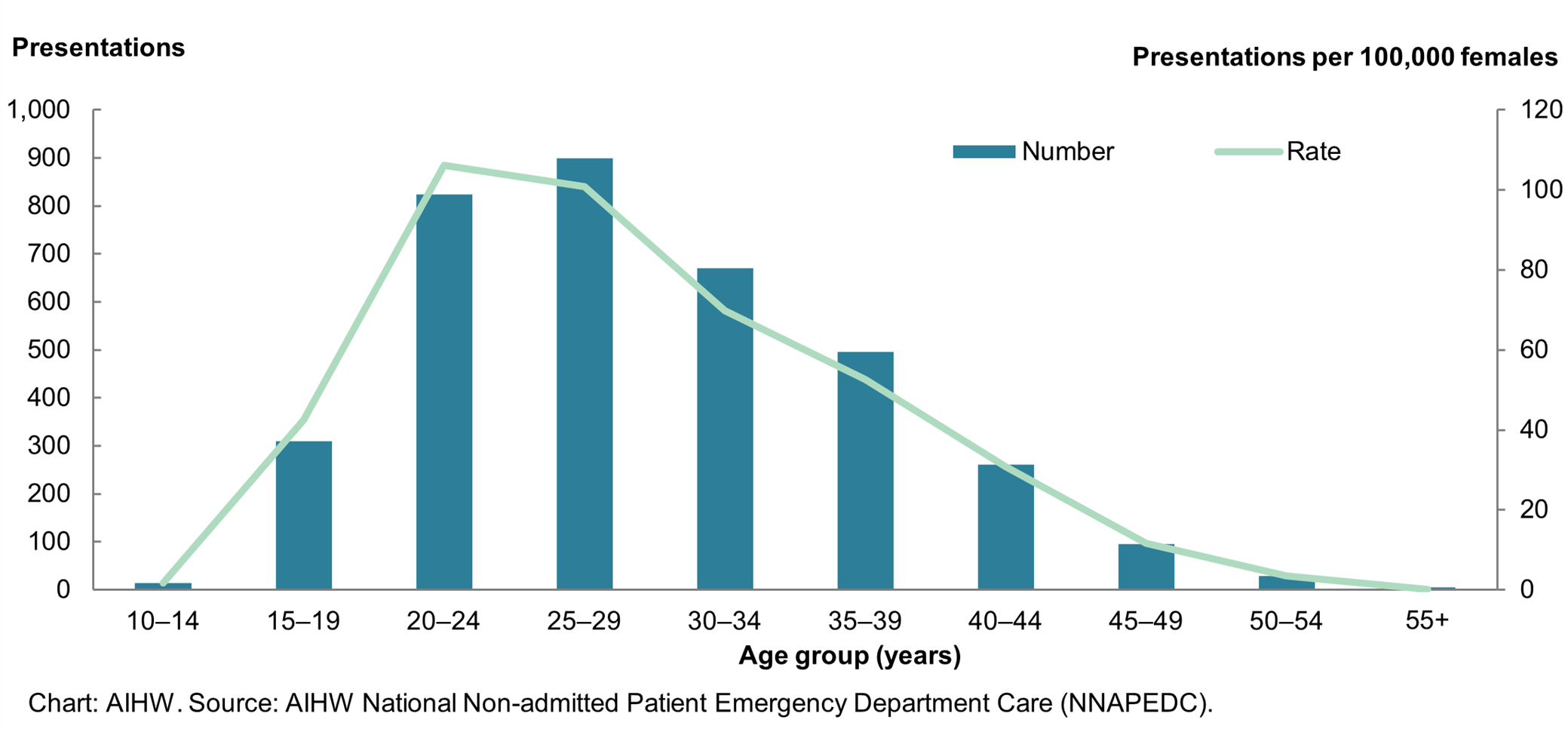Emergency Department presentations
Page highlights
- There were more than 3,600 endometriosis-related emergency department (ED) presentations in 2021–22. This represents around 28 presentations per 100,000 females.
- The rate of endometriosis-related ED presentations was highest in the 20–24 age group.
- The number and rate of endometriosis-related ED presentations has fluctuated between 2018–19 and 2021–22, peaking at 3,700 presentations in 2020–21.
- 72% of endometriosis ED presentations were triaged as needing to be seen within 30 minutes or less.
Almost all (95%) endometriosis-related ED presentations had endometriosis listed as the principal diagnosis.
Most endometriosis-related ED presentations were among females aged 15–44 (Figure 8). The rate of endometriosis-related ED presentations was highest in the 20–24 age group.
Around 71% of endometriosis-related ED presentations in 2021–22 ended with the patient leaving the hospital without being admitted or referred to another hospital. For 27% of the endometriosis-related presentations the patient was admitted to the same hospital for further care.
Figure 8: Number and rate of endometriosis-related emergency department presentations, by age group, 2021–22

What is an endometriosis-related emergency department presentation?
Emergency department data presented here are based on non-admitted patient episodes of care from the National Non-admitted Patient Emergency Department Care Database (NNAPEDCD), including multiple events experienced by the same individual in a given time frame.
- An emergency department provides triage, assessment, care and/or treatment for patients suffering from medical conditions and/or injury.
- Endometriosis-related emergency department presentations are emergency department presentations with a principal and/ or additional diagnosis of endometriosis.
- Triage is the process by which a patient is briefly assessed to determine the urgency of their problem and priority for emergency care.
The health classification used for emergency department presentation diagnosis reporting in Australia is the Emergency Department ICD-10-AM Principal Diagnosis Short List.
For further information on the NNAPEDCD and the methods used in this report, see the Technical notes.
Triage category
Triage category is used to indicate the level of urgency of a patient’s need for care. Of all endometriosis-related ED presentations in 2021–22:
- 9.5% were categorised as ‘resuscitation’ (requiring immediate care) or ‘emergency’ (within 10 minutes)
- 63% as ‘urgent’ (within 30 minutes)
- 26% as ‘semi-urgent’ (within 60 minutes)
- 1.4% as ‘non-urgent’ (within 120 minutes).
Trends over time
The number and rate of ED presentations due to endometriosis (where endometriosis was the principal diagnosis) has fluctuated in recent years. Between 2018–19 and 2021–22 (the period for which reliable diagnosis information is available nationally), the highest number of ED presentations due to endometriosis was in 2020–21 with 3,700 presentations (Figure 9). This is a similar pattern to that seen among all female ED presentations in this period, likely influenced by the COVID-19 pandemic. As additional years of data become available in future, it will be possible to gain a better understanding of trends in endometriosis ED presentations.
An individual may present to the ED with symptoms of endometriosis before they have received a diagnosis. In these cases, diagnoses related to pain, abnormal bleeding or menstrual issues are likely to be recorded. Figure 9 displays ED presentations for several diagnoses which may be related to endometriosis.
Figure 9: Emergency Department presentations for endometriosis and other selected diagnoses (principal diagnosis), 2018–19 to 2021–22
Alt text: This interactive line and bar chart shows the number and rate of emergency department presentations due to endometriosis and other selected diagnoses, including abnormal vaginal or uterine bleeding, acute pain in abdomen, pain in upper abdomen, pain in lower abdomen and other pain in abdomen. Other pain in abdomen was the diagnosis with the highest number and rate of ED presentations in all years.



